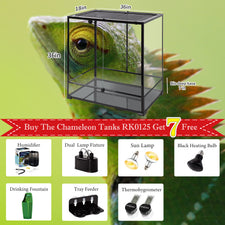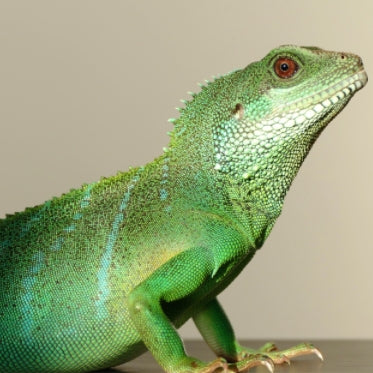Such an awesome, friendly pet is the Chinese water dragon. They are also known by the names Asian, Green, and Thai water dragons.
Pets make our lives extra special. While most of us immediately associate “pets” with dogs and cats, there are a few who like to nurture some other pets - maybe reptiles and amphibians.
To ensure you take the best care of your pet, we have chalked everything you need to know on the behaviors, housing, heat, light and humidity requirements, and more. Read on to delve into the various characteristics of Chinese water dragons and the tips to raise them well.
Everything To Know About Your New Reptile Friend - Chinese Water Dragon
Before you buy or adopt a Chinese water dragon, it’s worth getting some idea about this amazing class of reptiles.
They come in a specific color.
Mostly appearing in shades of dark or light green, Chinese water dragons have slanting turquoise-colored stripes all over their body. They are characterized by typically pale yellow bellies and a long, narrow tail.
They grow large.
Adult males are easily spotted by their large heads and huge crests on the back of their heads or neck. Males weigh up to 0.6 kg, while females weigh around 0.25 kg. Adults grow 5 to 6 feet tall and 2 to 3 feet deep in size, requiring a lot of space. They have a long tail that forms 70% of their total body length.
They are social animals.
Well, they are known to have the friendliest nature among all lizards. The best part is that they enjoy being touched. Regular handling is essential to keep them in good shape and maintain their temper at levels.
They are great swimmers.
Besides, they are excellent swimmers and like to have water in their surroundings. With their amphibian nature, they like to wallow as much in the water as on dry surfaces.
They enjoy climbing and basking.
They love moving and climbing up the trees, rocks, and plants. Their agile tendency and body structure let them climb and run around the branches, which is often a way they keep themselves active.
They gel well with other water dragons.
One key point to note is that these creatures enjoy being in the company of other Chinese water dragons. While a male and female get along well, those of the same sex may be a little violent initially.
They live longer when captive-bred.
Captive-bred Chinese water dragons typically live for 10-15 years. If they are cared for well, they may live up to even 20 years.
Chinese Water Dragon (Starters) - Care Sheet
Housing Needs
Finding a perfect chinese water dragon enclosure is the key consideration when you bring in your pets. With an adult dragon being huge and weighing heavy, your enclosure must be customized to this size to offer your pet a comfortable moving space.
Besides, bring another Chinese water dragon only when you are aware of the gender of the first. While a male and female would get along well, both males and females could turn aggressive. In any case, your enclosure must be well-spaced to accommodate them while letting them have fun.
Now that you have chosen the tank, the next step is to find a substrate. It should be something safe – that does not cause anything if ingested. It is advisable to go for indoor/outdoor carpets or paper. To let them have fun climbing, you can have branches and some live plants like pothos, ficus, or hibiscus.
Diet and Nutrition
The most crucial aspect of any living creature is its diet. Chinese water dragons are omnivores and prefer meat over fruits and vegetables, if possible. They are voracious eaters and love eating various meals the entire day. This leaves the question – what to feed them with?
The rule of thumb is their diet must contain 50% live insects, 20% worms, and 15% fruits and vegetables.
You can feed your water dragon with:
- Butterworms, earthworms, waxworms, small feeder fish, and locusts.
- Adult Chinese water dragons can be fed fuzzies and mice.
It’s best to avoid feeding them with wild insects or fireflies as they are toxic, and some may contain pesticides. Further, ensure you feed the insect prey only every two or four weeks – not daily.
Feed your pet water dragon with a small amount (10-15 percent) of finely chopped vegetables and fruits.
- Vegetables - carrots, parsnips, green beans, sweet potatoes and such. Alternatively, you can give them dandelions, collards, and orange squash.
- Fruits - raspberries, strawberries, figs, papaya and mangoes. However, fruits must be fed in much less quantity than vegetables.
Another critical factor to remember is the frequency at which you feed them. This depends on their growth level and body condition.
- Adults must be fed two to three times a week; juveniles must be fed every second day. You can feed your adult water dragon daily, but ensure you do it in small portions so it doesn’t get overweight.
- Thin, slimy water dragons must eat more, while chubby ones should eat less.
Supplements
Make sure to use a calcium or Vitamin D3 supplement on the food at every other feeding, along with a complete dose of vitamin and minerals supplements each week.
Calcium is essential for their growth, the lack of which could lead to Metabolic Bone Disease. Remember: Don’t feed calcium and multivitamins on the same day.
Humidity Requirements
Your pool must be large and deep enough to accommodate the dragon. Ensure it’s enough to submerge them to half their size. Next, you need to arrange a water bowl.
You can use something like a kitten’s litter box wherein you fill half of the enclosure with water, and the other half can be used like a beach using substrates. This way, you could clean and remove the tub daily while your pet uses it as a toilet.
Your pet water dragon must always be in an enclosure with 80% humidity. To keep a tab on this, always use a digital hydrometer. Make sure you mist the enclosure once or twice daily. Besides, potted live plants also help boost the humidity levels.
Heating and Lighting Needs
You should ensure that daytime temperatures are between 80 and 88 degrees Fahrenheit with a basking spot of 95 degrees Fahrenheit. At night, the preferable temperature is 75 to 80 degrees Fahrenheit. Use a temperature gradient and measure the temperatures on both the warm and cool sides.
Your water dragon must be exposed to at least 12-13 hours of light cycle in the summer, while in the winter, it must be preferably 11-12 hours a day. Adequate UVB exposure is vital to your water dragon’s bone health, and you must ensure there aren’t any blockers in this regard.
Common Health Problems
Familiarize yourself with some common health problems that occur in Chinese water dragons.
Mouth Rot
Cause: A common health issue in Chinese water dragons, caused usually by improper treatment of an infection or an injury. Inadequate or lack of nutritious diet can also lead to mouth rot.
Symptoms: Your pet banging its head or neck on the surface of the enclosure. This kind of behavior can result in the rubbing of sores, leading to complete mouth rot.
How to find out: Check the mouth swelling or open ulcers around the mouth or nose parts.
Treatment: Consult a vet and get the required medication.
Metabolic Bone Disease
Cause: A serious health condition, often fatal, caused in water dragons due to a deficiency of calcium in their diet or insufficient exposure to UVB light.
Symptoms: Weak, fragile growth.
Treatment/Prevention: Feed calcium supplements in food. Provide enough light in the enclosure.
Skin Diseases
Cause: Water dragons are susceptible to skin infections or diseases affecting the outer body surface. These are primarily caused due to ill-maintained, dirty, or poorly lit cages. Due to unclean conditions, parasites develop in your pet’s body.
Symptoms: You may see some abnormalities in the outer body surface.
Treatment/ Prevention: Cleaning the enclosure regularly is crucial.
For skin infections or parasites, you must immediately take your Chinese water dragon to a vet.
To prevent internal parasite infections, you can buy insects, worms, or such from a pet store or raise them independently.
Dystocia or Egg-binding
Cause: Female water dragons lay eggs even without mating. Sometimes, the egg might get stuck in their body.
Treatment: You must consult a vet in case you think there’s an egg stuck inside your pet’s body.
Purchasing or Adopting a Chinese Water Dragon
You don’t need to shell out a lot if you wish to have a Chinese water dragon as a pet. Buy your pet from a reliable breeder or a pet store. It would cost on average $50.
Summary
It is excellent if you plan on bringing home more than one Chinese water dragon because they would enjoy each other’s company, and the cost for you will not be much.
This care sheet on Chinese water dragons would be of great help to starters in preparing themselves for how to take care of their new reptile friend. Allow some time for your baby water dragon to get accustomed before you two gel well!











